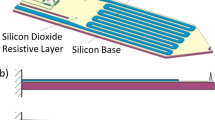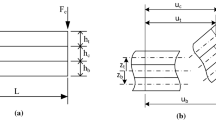Abstract
This paper proposes a simple methodology to analyse numerically the effects of air damping on the oscillatory motion of heated micro-cantilevers. The proposed methodology is fully solved by the fluid solver, because the solid domain is embedded into a subroutine executed at the end of each time step. The methodology is first validated against numerical and experimental data yielding acceptable results. Next, it is applied to predict the quality factor of a micro-cantilever heated by an electric resistance inserted inside it. The transferred heat flow and the evolution in time of temperature are analysed and the quality factors of both heated and isothermal micro-cantilevers are compared.












Similar content being viewed by others
Abbreviations
- A :
-
Area (m2)
- b :
-
Width of the micro-cantilever (m)
- B :
-
Constant to evaluate Young’s Modulus of silicon in equation 9 (15.8 MPa/K)
- C :
-
Damping constant (kg/s)
- c cr :
-
Critical damping (kg/s), \( C_{\text{cr}} = 2m_{\text{eq}} \omega_{n} \)
- c eq :
-
Equivalent damping (kg/s)
- E :
-
Young’s Modulus (GPa)
- E 0 :
-
Young’s Modulus of silicon at T 0 (167.5 GPa)
- f :
-
Frequency (Hz)
- F Fl :
-
Fluid force (N)
- F i :
-
Fluid force transferred to element i (N)
- F ni :
-
Fluid force transferred to node i (N)
- h :
-
Thickness of the micro-cantilever (m)
- i :
-
Enthalpy (J)
- k :
-
Thermal conductivity of air (W/m K)
- K :
-
Stiffness constant (kg/s2)
- Kn :
-
Knudsen number (dimensionless)
- l :
-
Characteristic length (m)
- L :
-
Length of the cantilever (m)
- L 0 :
-
Cell size attached to the micro–cantilever walls (m)
- L Out :
-
Cell size attached to the outer limits (m)
- m eq :
-
Equivalent mass (kg), \( m_{\text{eq}} = 0.24\rho_{C} hbL \)
- M :
-
Mass constant (kg)
- n :
-
Oscillation (dimensionless), n = f × t
- Nu :
-
Nusselt number (dimensionless), \( Nu = \frac{q \cdot l}{{A\left( {\bar{T}_{C} - T_{\infty } } \right)k}} \)
- N y,Fluid :
-
Number of fluid cells between the micro-cantilever and the upper or bottom sides (dimensionless)
- N y,Solid :
-
Number of fluid cells in the micro-cantilever thickness (dimensionless)
- P :
-
Pressure (Pa)
- P Op :
-
Operating pressure (101,325 Pa)
- q :
-
Heat flow transferred through the micro-cantilever walls (W)
- q gen :
-
Heat flow generated inside the micro-cantilever (W)
- Q :
-
Quality factor (dimensionless)
- R :
-
Ideal gas constant (8.314 J/mol K)
- t :
-
Time (s)
- T :
-
Temperature (K)
- \( \bar{T}_{i} \) :
-
Volume weighted average of the temperature of the element i in which the micro-cantilever is divided (K)
- \( \bar{T}_{C} \) :
-
Volume weighted average of the temperature of the micro-cantilever (K)
- T* :
-
Dimensionless temperature defined in equation 10
- T 0 :
-
Reference temperature to calculate Young’s Modulus of silicon (317 K)
- T ∞ :
-
Fluid temperature far from the micro-cantilever (300 K)
- U, V, W :
-
Components of the velocity vector (m/s)
- x, y, z :
-
Spatial directions (m)
- \( Y \) :
-
Micro-cantilever displacement (m)
- \( \dot{Y} \) :
-
Micro-cantilever velocity (m/s)
- \( \ddot{Y} \) :
-
Micro-cantilever acceleration (m/s2)
- \( \alpha \) :
-
Thermal diffusivity (m2/s)
- \( \lambda \) :
-
Mean free path of air molecules (m)
- \( \nu \) :
-
Kinematic viscosity (m2/s)
- \( \rho \) :
-
Fluid density (kg/m3)
- \( \rho_{C} \) :
-
Micro-cantilever density (kg/m3)
- \( \omega_{\text{n}} \) :
-
Undamped natural frequency (Hz), \( \omega_{\text{n}} = 3.52\frac{h}{{L^{2} }}\sqrt {\frac{E}{{12\rho_{C} }}} \)
- \( \zeta \) :
-
Damping ratio (dimensionless), \( \zeta = \frac{{C_{\text{eq}} }}{{C_{\text{cr}} }} \)
- ∇·V :
-
Divergence of the velocity vector (s−1)
- CFD:
-
Computational fluid dynamics
- CSD:
-
Computational structural dynamics
- FEM:
-
Finite element method
- FFT:
-
Fast fourier transform
- FSI:
-
Fluid-structure interaction
- MEMS:
-
Micro-electro–mechanical systems
References
ANSYS Inc. (2009) ANSYS-FLUENT 12.1 User’s Guide, ANSYS Inc, Lebanon, USA
Doll JC, Corbin EA, King WP, Pruitt BL (2011) Self-heating in piezoresistive cantilevers. Applied Physics Letter 98:223103
Gad-el-Hak M (2006) The MEMS Handbook, 2nd edn. Taylor & Francis Group, Boca Raton
Guyan RJ (1960) Reduction of stiffness and mass matrices. AIAA J 3(2):380
Issa RI (1986) Solution of the implicitly discretized fluid flow equations by operator-splitting. J Comput Phys 62:40–65
Issa RI, Gosman AD, Watkins AP (1986) The computation of compressible and incompressible recirculating flows. J Comput Phys 62:66–82
Khanafer K, Vafai K (2010) Microcantilevers in biomedical and thermo/fluid applications. Frontiers in Heat and Mass Transfer, 1, 023004, doi:10.5098/hmt.v.1.2.3004
Khanafer K, Alamiri A, Pop I (2010) Fluid–structure interaction analysis of flow and heat transfer characteristics around a flexible microcantilever in a fluidic cell. Int J Heat Mass Transf 53:1646–1653
Lee JH, Lee ST, Yao CM, Fang W (2007) Comments on the size effect on the microcantilever quality factor in free air space. J Micromech Microeng 17:139–146
Lienhard JH IV, Lienhard VJH (2008) A heat transfer textbook, 3rd edn. Phlogiston Press, Cambridge Massachusetts
Mohd Z, Ansari CC (2012) A conduction–convection model for self-heating in piezoresistive microcantilever biosensors. Sensors and Actuators A: Physical. doi:10.1016/j.sna.2011.12.014
Pina MP, Pellejero I, Urbiztondo M, Sese J, Santamaria J (2011) Explosives detection using nanoporous coatings, micro-and nanotechnology sensors, systems, and applications III. SPIE, Orlando
Rohsenow WM, Hartnett JP, Cho YI (1998) Handbook of heat transfer, 3rd edn. Mac Graw Hill, New York
Thomson WT (1993) Theory of Vibrations with Applications, 4th edn. Prentice Hall, Englewood Cliffs
Urbiztondo MA, Pellejero I, Villarroya M, Sesé J, Pina MP, Dufour I, Santamaría J (2009) Zeolite-modified cantilevers for the sensing of nitrotoluene vapors. Sens Actuators B Chem 137(2):608–616
Versteeg HK, Malalasekera W (1995) An introduction to computational fluid dynamics: the finite volume method. Addison Wesley Longman Limited, Harlow
Yovanovich MM, Jafarpur K (1993) Models of laminar natural convection from vertical and horizontal isothermal cuboids for all prandtl numbers and all rayleigh numbers below 1011, ASME Winter Annual Meeting, New Orleans, Louisiana, Nov.28–Dec.3, HTD–Vol.264, p 111
Acknowledgments
This work was partially supported by the Research Project PI 110/08 “Diseño y desarrollo de arrays de sensores tipo micro-cantilevers para la detección de explosivos entre mezclas de gases” funded by the Government of Aragon. Moreover, GICSERV actions (87, 138) with CNM-CSIC are gratefully acknowledged.
Author information
Authors and Affiliations
Corresponding author
Rights and permissions
About this article
Cite this article
Miana, M., Bernal, E., Paniagua, J. et al. A simple numerical methodology for thermal-fluid-structural interactions of air damping over heated micro-cantilevers. Microfluid Nanofluid 13, 131–140 (2012). https://doi.org/10.1007/s10404-012-0951-5
Received:
Accepted:
Published:
Issue Date:
DOI: https://doi.org/10.1007/s10404-012-0951-5




